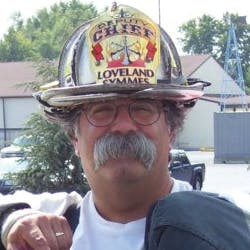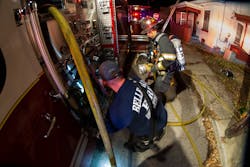Close Calls: It’s a Fire until We Determine It Isn’t
Although you might dream about every dispatch that you are sent on being “the big one,” obviously, that isn’t the case in reality. From alarm systems and smoke investigations to “odors” or whatever the public comes up with, fire departments are the last resort for help. Our reputation is and must be that, if we’re called, we will fix it. Thankfully, that is the case of most fire departments.
But do you want to see firefighters roll their eyes? Then transmit an automatic fire alarm. Those runs so dampen our spirits as firefighters, because, after all, they almost always are false alarms. And false alarms are not what we are here for!
But, hold on.
Maybe, regardless, we stick to the old adage that “When the bells go off, it’s a fire until we get there and determine that it is not.” That’s how it’s supposed to work. When an automatic alarm is received and transmitted, we respond based upon our department’s policies. Respond as directed. Prepare. Pack up. Size up. Identify your water. Be ready to stretch and do so until a fire officer says to stop.Nevertheless, false automatic alarms can be challenging. In many cases, if the agency that has jurisdiction would work on repairing the system with the owner and enforce local false alarm laws, the number of false alarms would be fewer. On the other hand, as technology improves, the problem of false alarms will lessen, and that will validate the automatic alarm call as even more potentially valid. We aren’t there yet, but we’re getting there.
So, who wants to be available for a real fire? Who doesn’t? However, we still have a job to do, and, sometimes, it isn’t up to us to decide to not do something.
In this column, accounts from Mike Ward of companycommander.com are reviewed. He is a veteran fire and EMS officer and an associate professor. (This is a rare time when a close-call story for this column doesn’t name the folks who were involved nor their department.)
Account from Mike Ward
I was an engine company lieutenant in an engine, truck and ambulance house with a probationary truck company sergeant. The sergeant (riding the truck) wasn’t following the battalion chief’s (BC) requirement that every automatic fire alarm response include an on-site inspection by the fire department before clearing the incident; if dispatch reported a reset alarm system or that “the caller wants to cancel,” the sergeant immediately would return to quarters without proceeding to make an inspection.
Our BC was a strict chain-of-command boss. As we were picking up from a commercial box alarm, he motioned me over. “Mike, your sergeant still isn’t inspecting activated alarm bell incidents. He did it again while covering Engine B on Saturday. This behavior has to stop now.”
This was the boss’s second notice to me. I didn’t want a third notice.
The bitter cold and the wind kept both units running calls well after midnight. At 4:30 a.m., the engine and truck responded together first due to an activated fire alarm at a trucking company garage in our industrial district. As we arrived, dispatch reported that the fire alarm system reset. I held the first engine and truck and returned the rest of the assignment. On the direct unit-to-unit radio channel, I told everybody to stay on the rigs; the sergeant and I would make a lap of the garage.
This allowed me to have face-to-face time with the sergeant. While walking around the garage, I repeated the BC’s expectations and concern about response on that previous Saturday. The sergeant’s response: Most of our activated fire alarms turn out to be false, and he didn’t want to miss a real fire while inspecting a nonfire.
The BC’s policy of proceeding to and visually inspecting the occupancy—unwritten and not a part of the department’s official regulations—came from his risk evaluation of two unfortunate, large-loss commercial/industrial fires in which the fire department responded three different times over a couple of hours to an activated fire alarm in an occupancy that lacked sprinklers.
In both incidents, the engine crew reset the alarm panel but didn’t inspect the source of the alarm. On the third activated fire alarm response, the fire had broken through a window and the roof, respectively. Both events grew to greater alarm incidents.
I explained this to the sergeant and made it clear that he needed to inspect every activated fire alarm occupancy. Continued failure to do this might result in a work-improvement plan.And, then, a fire with a victim
Our walk around the garage showed no evidence of smoke or fire when we looked through the truck bay doors and front office windows. I released the truck company and told dispatch that we would wait for the keyholder. (I knew that the owner was coming, and I wanted to use the opportunity to also try to get a lockbox installed, so if we needed to in the future we could gain access to the building without the owner needing to drive to the building in the middle of the night.)
Two things weren’t right when the owner and I entered the garage. The 1970s-era fire alarm system showed a trouble light, and we smelled smoke.
There was a drivers’ lounge in the garage, added like a mezzanine. It had bathrooms, a kitchenette, a big-screen TV, a dining table and two couches. When the owner opened the lounge door, thick, black smoke rolled out of the room. As the smoke lifted, I could see a dull orange glow and a snoring body on a couch.
I radioed in the fire, requested EMS and removed the soundly sleeping driver from the room. A primary search found no one else. A tipped-over kerosene heater was the cause of the smoke.
The bad weather made this driver hours late in his return to the garage. He decided to sleep in the lounge. He used alcohol and a kerosene heater to keep the chill at bay. At some point, he kicked over the kerosene heater. When the smoke detector activated the central fire alarm station, a connection failed. That failure was reported to the central station as an alarm reset.
What would have happened if nobody entered the garage until work started at 8 a.m.? At the times when I am awake during a frigid, winter pre-dawn, with brightly twinkling stars in a violet-blue sky, I shudder at the still vivid memory of “what could have been.”
Chief Goldfeder comments
I remember as a young firefighter and then as a company officer in the 70s that every run meant it was a run. The dictionary defines “run” as “to go faster than a walk.” Yep, that’s it. When our tones went off, and we had a run, we ran (way faster than a walk!) to the rig for whatever we were dispatched. We took extreme pride in a rapid turnout, in being a company that always was ready. (Our shirts had that written on them.) We proudly were “always on the job.”
Not too many years ago, I watched an engine company get toned for someone having trouble breathing. (As far as I know, trouble breathing sucks.) To my shock, the driver went to the rig, started it (reaching in from the bay floor) and then, as the rig warmed up, walked to the front ramp and lit a cigarette. The crew walked to the rig about a minute or two later. It was like something from the “Twilight Zone.” Their behavior was beyond belief.
Later, the officer quietly stating to me, “Chief, not everyone is into this job like you are,” did nothing to help their case.
That crew never repeated that sort of thing again.
Despite our own lack of giving a damn, forgetting the mission or poor training, or the lack of policy, leaders forgetting to lead or whatever, we have a clear obligation to fully investigate and correct any problem to which we’re dispatched. It’s not an option nor something that we get to vote on. We must thoroughly determine the reason why we were called.
In the last several years, a couple of fire departments made headlines for their company’s (officers and chiefs) failing to fully investigate runs—meaning not getting out of the apparatus as if there is a fire and doing all of the things that we’re expected to do by policy—or by nationally recognized best practices.
Once again, the mantra “Treat it as if it were your own home” works well.
Even in the case where people actually reported a fire, the department failed to properly investigate.
A few years ago in Florida, a dispatcher was fired and a firefighter resigned in the wake of an internal investigation. A fire destroyed numerous condo units and caused an estimated $2.5 million in damage. The first caller said she smelled a strong odor of smoke. The initial crew responded, looked from the rig, saw nothing, never got out of the apparatus and never spoke to or asked for contact with the caller. The crew returned to quarters after being on scene for less than a minute. Following that, a dispatcher declined to send a second crew, because the first one found no sign of fire.
In Georgia, firefighters responded to an early morning run, and, when they couldn’t find a fire, they returned to quarters. (They didn’t identify the building, didn’t face-to-face with a caller and didn’t check out the structure.) Sadly, firefighters returned 5 hours later, after a 9-1-1 call from neighbors, to find the house well involved. A woman’s body was found in the home’s remains after the fire was extinguished.
There is no doubt in my mind that it’s a rare firefighter who would ever maliciously blow off a run, but it happens—and happens because we get distracted, we want to head back to quarters or whatever excuse we come up with. Sometimes, we become so accustomed to ourselves or to those who are around us simply not “giving a damn” that the department becomes accustomed to that behavior—even though it’s far from how we were trained.
When that kind of behavior is identified, the correction starts with the individual who identifies the behavior. Regular systems of policy and training help to keep that from happening. When that fails, it falls on the company officer to make the needed corrections or, better yet, to maintain regular company training, so all department policies and operational expectations are covered regularly. Will that place company officers in a challenging position to have to face their subordinates, do some training and get back to operating as expected? Yes. Welcome to your job. Naturally, if the corrections aren’t attainable, the chain of command gets involved.
Years ago, in all of our communities, some good folks built a building and hung a sign on the front that read, “Fire Department.” The reasonable expectation is that when people call us for help, we are going to give them 100 percent, regardless of the run. Exciting. Boring. Whatever. We are expected to go all the way to assure that their problem (reported, real or perceived) is investigated fully, identified and professionally taken care of. It’s what we swore to do, what we are trained to do, and it’s what the public expects.
Here’s a thought: Your mom calls the fire department. How do you want her request handled?
About the Author
Billy Goldfeder
BILLY GOLDFEDER, EFO, who is a Firehouse contributing editor, has been a firefighter since 1973 and a chief officer since 1982. He is deputy fire chief of the Loveland-Symmes Fire Department in Ohio, which is an ISO Class 1, CPSE and CAAS-accredited department. Goldfeder has served on numerous NFPA and International Association of Fire Chiefs (IAFC) committees. He is on the board of directors of the IAFC Safety, Health and Survival Section and the National Fallen Firefighters Foundation.



